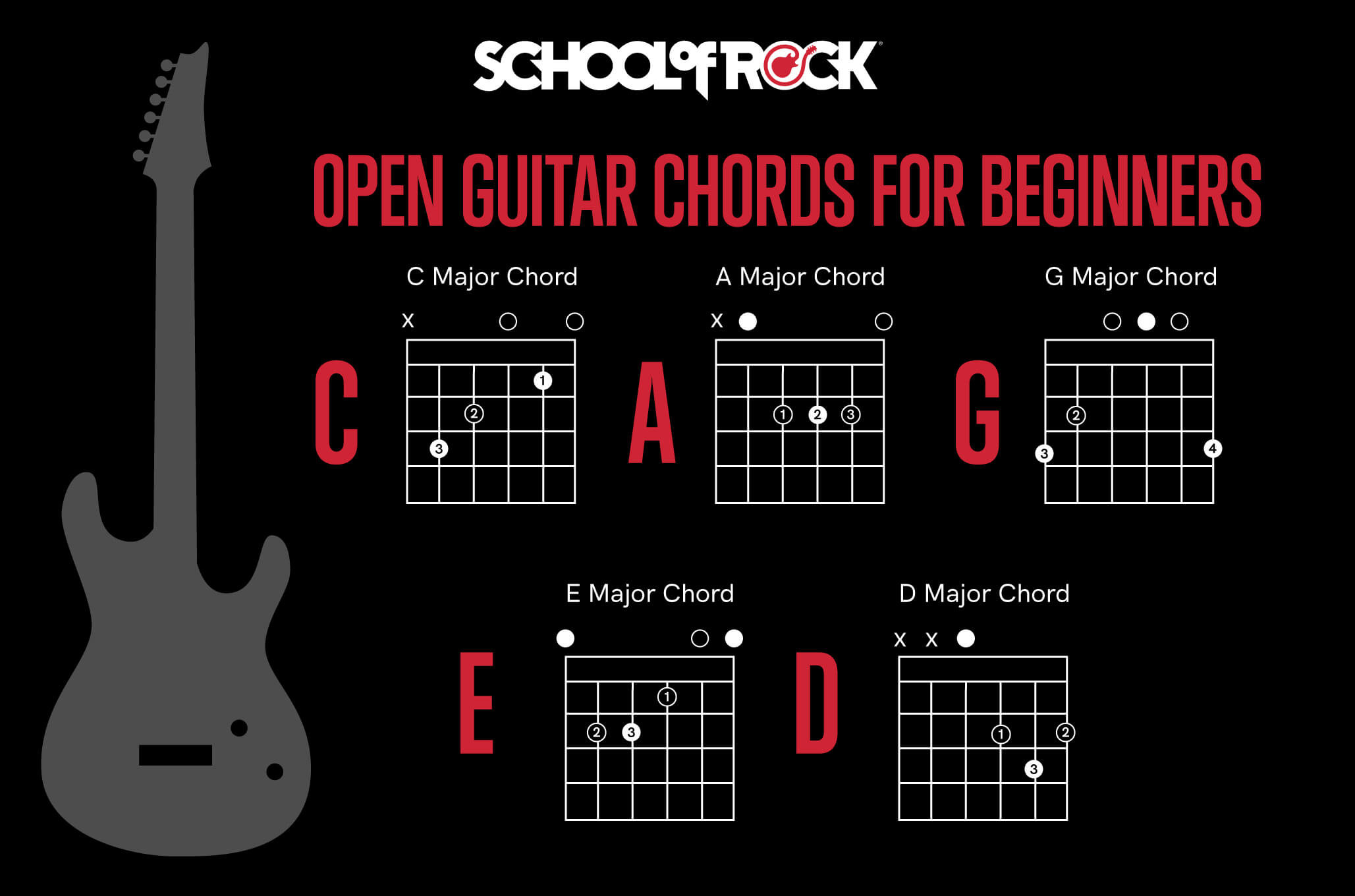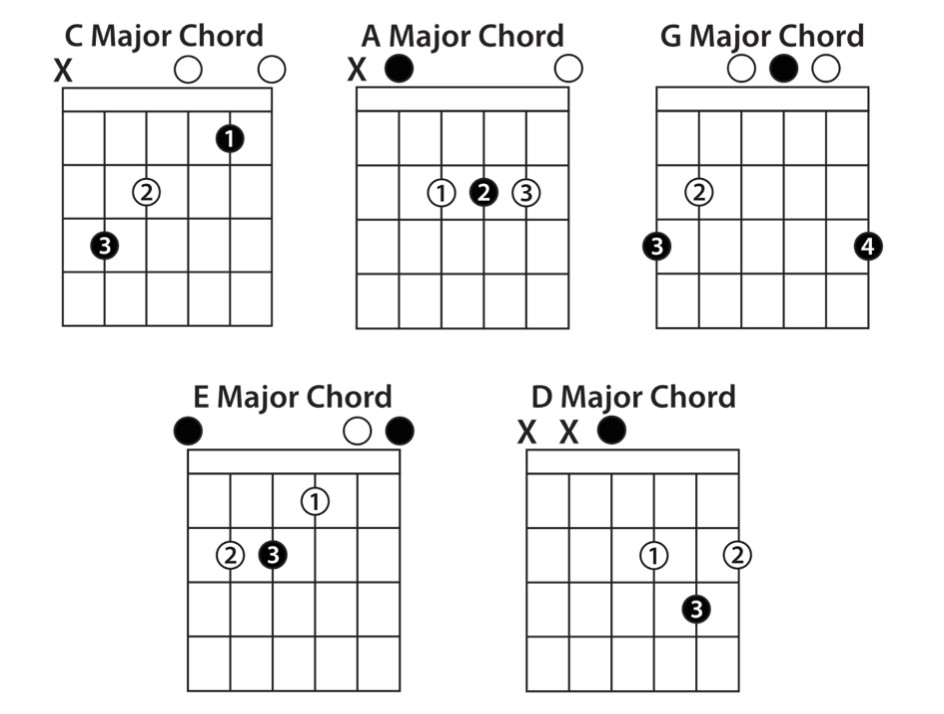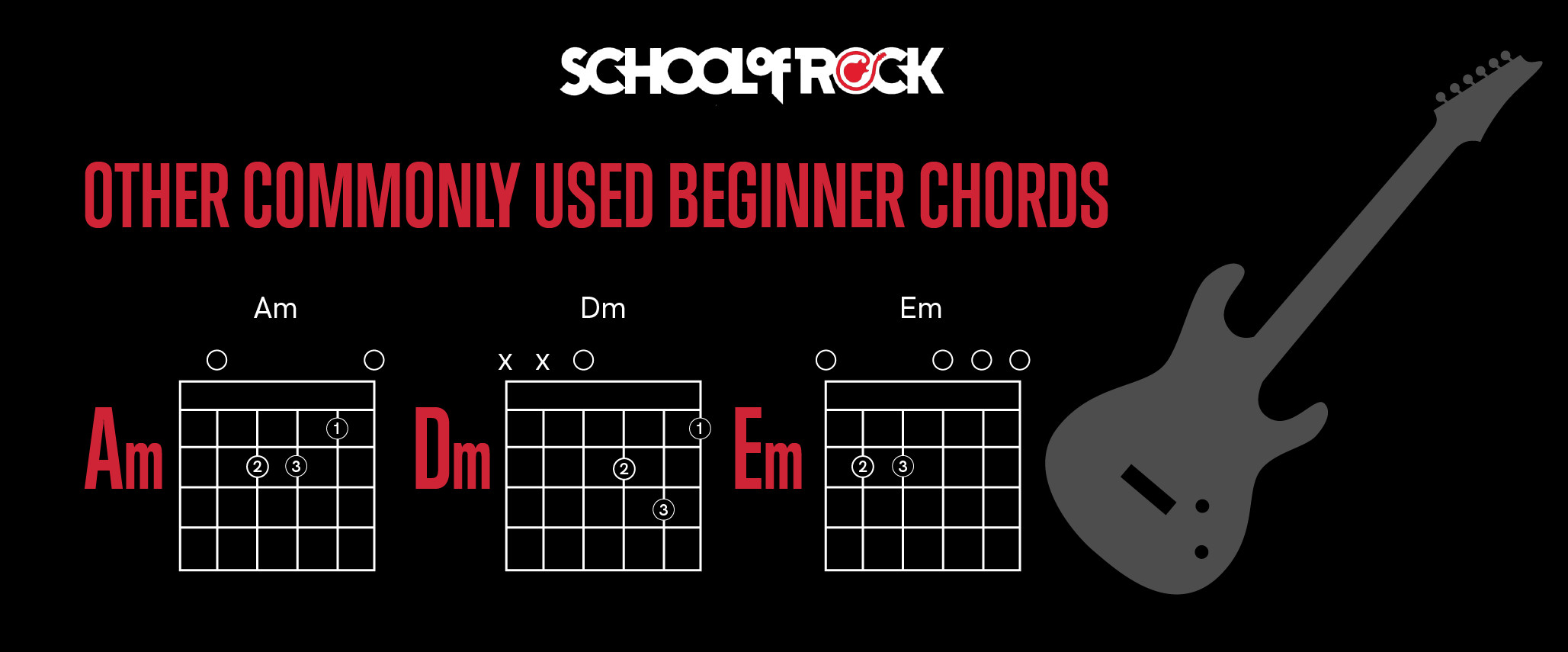Picking up a guitar for the first time is exciting. Your fingers are itching to play, but where do you even begin? The answer for many aspiring guitarists lies in learning Easy Guitar Chords. Chords are the building blocks of harmony in music. They provide the richness and depth that make songs sound complete. While drums keep the beat and bass adds the low-end foundation, chords are what most instruments, especially guitars, use to create musical structure and interest.
This guide will walk you through essential easy guitar chords perfect for beginners. We’ll cover different types of chords, provide tips and tricks for playing them cleanly, and even suggest some popular songs you can start learning right away.
At institutions like School of Rock, learning chords is a fundamental part of the curriculum. They understand that mastering rhythm guitar, which heavily relies on chords, is just as crucial as learning lead guitar techniques like melodies and solos. Whether you dream of strumming rhythmically or shredding solos, understanding and playing chords is an indispensable skill. If you’re just starting your guitar journey and need some guidance on choosing the right instrument, check out resources like this guitar-buying guide for helpful advice.
Diving into Basic Guitar Chords
Learning guitar chords can seem daunting at first. There are many types, and different ways to play each one. However, beginner-friendly chords are designed to be accessible and form a solid foundation for your guitar playing journey. Generally, we can categorize basic guitar chords into a few main types:
Power Chords: The Rock Starter
Power chords are often the first type of chord beginners encounter, and for good reason. They are incredibly common in rock, metal, punk, and even pop music. What makes power chords easy is their simplicity: they typically involve only two or three strings and require fewer fingers than other chord types. This makes them physically less demanding for beginners.
Power chords are particularly popular on electric guitars. When played with overdrive or distortion, they create a powerful, thick sound that is characteristic of many genres. While you can use distortion with other chord types, it’s power chords that really define the energy and mood of many rock songs.
Open Chords: Your Gateway to Full Sound
Open chords are another excellent starting point for guitarists. Like power chords, they are generally considered easy guitar chords for beginners because they utilize fewer frets and fingers compared to more complex chords. The defining feature of open chords is that they incorporate open strings – strings that are played without being fretted by your left hand. Unlike power chords which often focus on the lower strings, open chords typically use all six strings of the guitar, resulting in a fuller, richer sound.
A set of fundamental open chords are often referred to as CAGED chords. We’ll explore these essential chords and how to play them in detail shortly.
Barre Chords: Stepping Up Your Chord Game
Barre chords represent the next level of chord complexity. They are more challenging than power and open chords initially, but mastering them unlocks a significant amount of versatility on the guitar. Barre chords are based on movable shapes. Once you learn a barre chord shape, you can slide it up and down the guitar neck to create different chords without changing the finger shape itself. This makes transitioning between barre chords efficient once you get the hang of it.
However, barre chords are known to be more difficult for beginners because they often require one or more fingers to press down multiple strings at the same fret simultaneously – the “barre” technique. While we won’t focus on barre chords in depth in this beginner guide, understanding their existence is important for your future guitar journey.
Mastering Open Guitar Chords: CAGED and Beyond
Before diving into specific open chords, it’s crucial to ensure your guitar is properly tuned. Playing in tune is essential for developing a good ear and making your practice sessions sound rewarding. If you’re unsure about tuning, many online resources and apps can guide you. For instance, School of Rock offers a beginner’s guide to tuning a guitar that provides helpful tips.
 Open Guitar Chords for Beginners
Open Guitar Chords for Beginners
Let’s explore CAGED chords, a set of open chords fundamental to many popular songs and the School of Rock curriculum. The acronym CAGED represents five common open chord shapes: C, A, G, E, and D major. These chords, along with some minor variations, form the bedrock of countless songs.
To understand how to play these chords, we’ll use chord diagrams.
Understanding Chord Diagrams
Chord diagrams are visual representations of the guitar fretboard, showing you exactly where to place your fingers to form a chord. They are read horizontally, with the thickest line representing the low E string (string 6) and the thinnest line representing the high E string (string 1). Imagine holding your guitar upright in front of you – that’s how the diagram is oriented.
- X above a string indicates a muted string – don’t play that string.
- O above a string indicates an open string – play that string without fretting.
- Numbers on the diagram indicate which finger to use: 1 (index), 2 (middle), 3 (ring), 4 (pinky).
- The vertical boxes represent frets. The top box is typically the nut (fret 0), and subsequent boxes are frets 1, 2, 3, and so on. If the numbers appear on the second box down, it means you are playing frets starting from the second fret.
Let’s look at an example using the A Major chord diagram: In this diagram, you see numbers on the second fret. This means all the fretted notes in this chord are on the second fret. The diagram shows finger 1 on the D string (4th string), finger 2 on the G string (3rd string) and finger 3 on the B string (2nd string), all at the second fret.
 Alt text: Chord diagram illustrating finger positions for the A Major open guitar chord, showing finger placement on the second fret of the D, G, and B strings.
Alt text: Chord diagram illustrating finger positions for the A Major open guitar chord, showing finger placement on the second fret of the D, G, and B strings.
Besides the CAGED chords, there are other easy guitar chords that are very common and beginner-friendly. These include E minor (Em), A minor (Am), and D minor (Dm).
 Alt text: Chord diagrams for common easy guitar chords: E minor (Em), D minor (Dm), and A minor (Am), showing finger positions for each chord.
Alt text: Chord diagrams for common easy guitar chords: E minor (Em), D minor (Dm), and A minor (Am), showing finger positions for each chord.
It’s important not to confuse chord diagrams with tablature (TAB). While both are used in guitar learning, they represent different information. Tablature is a way to represent musical notes visually, showing you which fret and string to play for melodies, riffs, and solos.
In tablature, horizontal lines represent the guitar strings, but they are read vertically, with the bottom line being the low E string and the top line being the high E string. Numbers on the lines indicate the fret to play on that string. “0” means an open string.
 Alt text: Example of guitar tablature showing numbers on lines representing frets and strings, used to read musical notes and guitar parts.
Alt text: Example of guitar tablature showing numbers on lines representing frets and strings, used to read musical notes and guitar parts.
Chord diagrams are specifically for chords, showing finger placement and which strings to play or mute. Tablature is for musical notation, showing you the sequence of notes in a song or riff.
Chord diagrams are invaluable tools for learning easy guitar chords. They not only show you the finger positions but often suggest the most efficient fingerings for smooth chord transitions. With practice, these chord shapes will become muscle memory, and you’ll be able to play them without constantly referring to diagrams.
Essential Tips for Playing Chords Cleanly
As you begin learning these easy guitar chords, keep these practice tips in mind to ensure you develop good technique from the start:
-
Fret Close to the Fret Wire: Position your fingers just behind the metal fret wire (the thin bar separating the frets). Fretting closer to the wire requires less pressure and produces a clearer sound. Experiment with finger placement to find the sweet spot.
-
Use Your Fingertips and Arch Your Fingers: Use the very tip of your fingers to press down the strings. Arch your fingers so that you are pressing down only the intended strings and avoiding accidentally muting adjacent strings. Imagine you are holding a small ball in your palm – this helps create the correct finger arch.
-
Practice Each String Individually: After forming a chord, strum each string separately to check for clarity. If a string sounds muffled or buzzy, adjust your finger position and pressure until each note rings out clearly. This helps isolate problems and correct your technique.
-
Practice Fretting and Unfretting: Practice transitioning into and out of chords smoothly. Lift your fingers off the fretboard and then quickly reform the chord shape. You can even hover your fingers just above the frets in the chord shape to build muscle memory for the shapes.
Songs to Play with Beginner Guitar Chords
Now that you’ve learned some easy guitar chords and practice techniques, let’s put them into action! Here are some popular songs that are fantastic for beginners because they primarily use the CAGED chords and some minor chords we’ve discussed:
- Sweet Home Alabama by Lynyrd Skynyrd: A classic rock anthem using just C, G, and D chords.
- Bad Moon Rising by Creedence Clearwater Revival: A catchy tune in the key of D, using G, D, and A chords.
- Love Me Do by The Beatles: An early Beatles hit in the key of G, featuring G, C, and D chords.
- Eleanor Rigby by The Beatles: A slightly more melancholic Beatles song in E minor, using C and variations of Em chords.
- Time of Your Life by Green Day: A popular acoustic ballad in G major, using G, C, Cadd9, and D5 power chords (you can easily substitute a regular D major chord).
- Island in the Sun by Weezer: A laid-back alternative rock song using Em, Am, D, and G chords throughout most of the song, with power chords in the bridge offering a chance to try both types.
- Boulevard of Broken Dreams by Green Day: Another Green Day hit, in F minor, using Em, G, D, and A chords, transitioning to power chords towards the end for added dynamics.
More Great Songs for Beginner Guitarists:
- Hey There Delilah by Plain White T’s
- Hallelujah by Leonard Cohen
- Redemption Song by Bob Marley
- Smoke on the Water by Deep Purple (main riff uses power chords)
- Stairway to Heaven by Led Zeppelin (intro and some sections use open chords)
- Hotel California by Eagles (intro uses open chords)
Power Chords: Simplified Yet Powerful
Power chords are often considered even easier guitar chords than open chords, and they share some similarities with barre chords in terms of technique. Compared to open chords, power chords are simpler because they involve fewer notes, typically just two or three, meaning fewer strings and frets to manage.
Let’s compare an A major chord and an A5 power chord to illustrate this. An A major chord contains the notes A, C#, and E. An A5 power chord contains only A and E. The A major chord has a root, third, and fifth, while the A5 power chord has a root, fifth, and octave (which is the same note as the root, just higher). In essence, they share the root and fifth notes. The key difference is that the power chord omits the third.
This omission of the third is what makes power chords neither major nor minor. The third of a chord determines whether it’s major or minor. Since power chords lack a third, they can be used effectively in place of either major or minor chords, depending on the musical context. When practicing, try switching between an open chord and its power chord equivalent to hear the difference in fullness and tonality.
While simpler than open chords in some ways, power chords share a technique similarity with barre chords – the “barre” technique, albeit simplified. Three-string power chords can be played using a mini-barre where one finger presses down two strings at the same fret. This is excellent practice for developing the finger strength and barre technique needed for full barre chords later on.
Power chords are the backbone of many genres. Classic rock, punk rock, and much of modern pop music heavily feature power chords. In beginner guitar programs like School of Rock’s Rock 101, power chords are a central element for learning these styles.
What songs can you play to practice power chords?
- Wild Thing by The Troggs: A garage rock classic using A5, D5, and E5 power chords, with occasional G5 power chords.
- Let It Be by The Beatles: Surprisingly adaptable! You can play this song with open chords (C, G, Am, F) or substitute power chords (C5, G5, F5) for a rockier feel.
- Rock and Roll by Led Zeppelin: A quintessential rock anthem built on A5, D5, and E5 power chords.
- I Love Rock and Roll by Joan Jett & The Blackhearts: A high-energy rocker using E5, A5, and B5 power chords.
- When I Come Around by Green Day: Almost entirely power chords: F#5, C#5, D#5, and B5.
- Rockin’ In the Free World by Neil Young: Starts with power chords (E5, D5, C5) then blends into open chords (Em, D, C), offering a great way to practice transitioning between both types.
 Other commonly used beginner guitar chords.
Other commonly used beginner guitar chords.
Ready to Take the Next Step?
Learning easy guitar chords is just the beginning of your musical journey! Are you excited to put these chords to use and learn even more? Do you feel you’d benefit from structured guidance?
School of Rock offers private music lessons and various music programs designed to help you progress from beginner to confident guitarist. Programs like Rock 101 and the Performance Program combine individual lessons with band rehearsals and live performances, providing a comprehensive and engaging learning experience. These programs use songs like the ones mentioned in this article to teach you open chords, power chords, and fundamental music theory in a practical, hands-on way. To discover more about how School of Rock can help you achieve your guitar goals, contact your nearest School of Rock location.
About the Author:
Miranda Morales is a guitar and keyboard instructor at School of Rock Easton in Pennsylvania.
